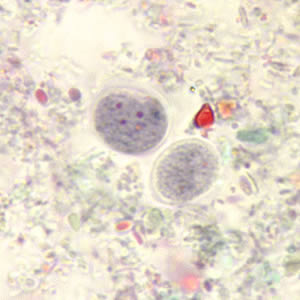Species belonging to this group are
the amoeba. This parasite move by simple extrusion of the protoplasm known as pseudopodia,
which is also use for food collection.
General rules in identifying
amoeba:
1. All
amoebas are non–pathogenic except E. histolytica.
2. All
amoebas are found in colon or large intestine except E. gingivalis.
3. All
amoebas can develop cyst and trophozoite except E. gingivalis & D.
fragilis.
Based on nuclear
characteristic, the Genus is divided into:
1. Entamoeba
– characterized by a small karyosome near the center of the nucleus and
numerous chromatic granules lining the nuclear membrane.
a. E.
histolytica
b. E.
coli
c. E.
gingivalis
2. Endolimax
– characterized by a relatively large karyosome of irregular shape and several
achromatic threads connecting it with a delicate nuclear membrane.
a. E.
nana
3. Iodamoeba
– characterized by a large karyosome (endosome) rich in chromatin, typically
surrounded by a single layer of periendosomal granules and attached to the
karyosome and the nuclear membrane by radiating achromatic fibrils.
a. I.
butschlii
4. Dientamoeba
– characterized by karyosome consisting of several chromatin granules embedded
in an achromatic matrix which is connected with a delicate nuclear membrane by
a very fine achromatic fibrils.
a. D.
fragilis
****** ENTAMOEBA HISTOLYTICA ******
Diseases: Amoebiasis, amoebic dysentery, amoebic
colitis
Morphology:
1. Cyst
– 3–20u, quadrinucleated, thin nuclear membrane, cigar–shaped chromatoidal body
2. Trophozoite
– 15–60u, long, fingerlike pseudopodia, progressive directional motility,
nucleus with central karyosome, “Bull’s eye karyosome,”cytoplasm contains RBC.
Two varieties:
1. E.
histolytica – larger, mean size is more than 10u; pathogenic
2. E.
hartmanii – small race, mean size is less than 10u; non–pathogenic
Comparison of cyst and
trophozoite
Trophozoite Cyst
Size
Small
race 5 – 12u 3 – 10u
Large
race 12 – 40u 10 – 16u
Motility & pseudopodia; active, progressive & spherical
shape of cyst directional; finger–like,
rapidly
extruded
Unstained organism motile or rounded; 1–4 nuclei not visible;
in saline nucleus not visible chromatoid matter refractile
RBC visible glycogen refractile in
young
cyst
Iodine stained nucleus visible nuclei
visible; chromatoids
seldom
seen; glycogen ball
in
young cysts
hematoxyline stained nucleus visible nuclei visible; chromatoids
stained;
glycogen unstained
Inclusions RBC, in amoebic dysentery; None
no
bacteria when in fresh stool;
no
RBC in small race
Chromatoid matter None Rods with rounded end
(cigar–shaped); irregular
in
small race
Glycogen None diffuse
in older cysts; mass
in
cysts with 1–2 nuclei
Nucleus single; ring–like 1–4 may be present
visible
in stained
preparations
Nuclear membrane delicate; head–like same as trophozoite
chromatin
dots
Karyosome small & centrally located same as trophozoite
Life cycle
****** ENTAMOEBA GINGIVALIS ******
Morphology:
1. Only
the trophozoite stage has been found and encystation probably does not occur.
2. Has
multiple pseudopodia; endoplasm contains phagocytosed and partly digested host
leukocytes epithelial cells, at times bacteria and spirilla; spherical nucleus
with a distinct membrane lined with a closely packed chromatin granules and
near the center, a moderately well – defined karyosome, with delicate
achromatic strands extending to the nuclear membrane.
Habitat
Gingival tissues around the teeth
especially in pyorrhea alveolaris, but also thrives in apparently hygienic
mouths or on dental plates if they are not kept meticulously clean.
Mode of reproduction Binary fission
****** ENTAMOEBA COLI ******
Size 15–50u 10–30u
Motility & pseudopodia sluggish, rarely progressive spherical
shape
of cyst & directional;
blunt
Unstained organism motile or rounded; nucleus 1–8 nuclei visible;
in
saline visible in
endoplasm behind chromatoid matter
pseudopod;
vacuoles seen refractile;
glycogen
refractile
in young cyst
iodine stained nucleus visible nuclei visible;
chromatoids
seldom
seen;
glycogen ball
Hematoxyline stained nucleus visible nuclei visible;
chromatoids
stained
glycogen
unstained
Inclusions bacteria and food debris None
no
RBC
Chromatoid matter bats
with splinter ends;
some
comma or needle
shaped
Glycogen None Diffuse
in older cysts
mass
with 1–2 nuclei
Nucleus single; ring–like; visible 1–8 may be present
in
all preparations
Nuclear membrane thick, coarse, irregular same as trophozoite
chromatin
dots
karyosome large eccentrically located same as trophozoite
****** ENDOLIMAX NANA ******
Trophozoite Cysts
Size 6–15u 5–14u
Motility & pseudopodia sluggish; hyaline budding ovoidal or spherical
shape
of cyst
unstained organism in motile or rounded; nucleus 1–4 nuclei not visible
saline not visible; vacuoles
seen
Iodine stained nucleus not visible nuclei visible
Hematoxylin nucleus visible; cytoplasm nuclei visible; no
Vacuolated chromatoids
seen but
bacilliform
bodies
maybe
seen
Inclusions bacteria & food debris none
no
RBC
Chromatoid matter None None
Glycogen None diffuse;
rarely has a
mass
in young cysts
Nucleus single; visible with hematoxylin 1–4 maybe present
and
other permanent stain only
nuclear membrane chromatin seldom present same as trophozoite
karyosome large, central or eccentric same as trophozoite
****** IODAMOEBA BUTSCHLII ******
Trophozoite
Cysts
Size 6–20u 5–20u
Motility & pseudopodia sluggish; hyaline; blunt irregular
shape
of cyst slowly extruded
Unstained organism in motile or produced nucleus nucleus not visible;
saline not visible glycogen
refractile
Iodine stained nucleus not visible nucleus not visible
Hematoxylin stained nucleus visible; cytoplasm nucleus visible; volutin
vacuolated
granules
stained;
glycogen
ball unstained
Inclusion bacteria & food debris; None
no
RBC
Chromatoid matter None None
Glycogen None usually
present as a
well–defined
mass
Nucleus single; visible with hematoxylin single
&
other permanent stains only
Nuclear membrane same as E. nana same as
trophozoite
Karyosome large,
central or eccentric; large;
usually eccentric;
surrounded
by refractile, achromatic
granules on
achromatic
granules side of
karyosome
****** DIENTAMOEBA FRAGILIS ******
Disease: Dientamoeba diarrhea or dientamebiasis
Morphology:
Size :
5 – 12u
Motility
& pseudopodia : active, hyaline, blunt & leaflike
Unstained
organism in saline : motile or rounded, nuclei not seen
Iodine
stained : stained not visible
Hematoxylin
stained : nuclei seen
Inclusion : bacteria & food debris; yeast; no
RBC
Chromatoid
matter & glycogen : none
Nucleus : Single but more frequently two
Nuclear
membrane : delicate but no chromatin dot seen
Karyosome : fragmented usually into 4 granules
or
tetrakaryosome or fragmented
karyosome















No comments:
Post a Comment